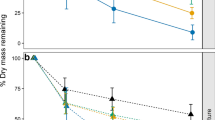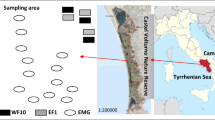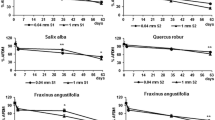Abstract
The decrease in litter decomposition rate in polluted habitats is well documented, but the factors that explain the observed variation in the magnitude of this pollution effect on litter decomposition remain poorly understood. We explored effects of environmental conditions and leaf quality on decomposition rate of mountain birch (Betula pubescens ssp. czerepanovii) leaves in a heavily polluted industrial barren near the nickel-copper smelter at Monchegorsk. Litter bags filled with leaves collected from two heavily polluted barren sites and from two control forest sites were buried at 2.5-cm depth and exposed for 2 and 4 years at each of these four sites. The relative mass loss of native leaves in the industrial barren during 2 years of exposure was reduced to 49 % of the loss observed in the unpolluted forest. We found a similar reduction in mass loss when leaves from control sites were exposed to polluted sites and when leaves from polluted sites were exposed to control sites. We conclude that the reduction in leaf litter decomposition in an industrial barren is caused by pollution-induced changes in both environmental conditions and leaf quality. This reduction is much smaller than expected, given the four-fold decrease in soil microbial activity and nearly complete extinction of saprophagous invertebrates in the polluted soil. We suggest that a longer snowless period and higher spring and summer temperatures at the barren sites have partially counterbalanced the adverse effects caused by the toxicity of metal pollutants.


Similar content being viewed by others
References
Aber JD, Melillo JM, McClaugherty CA (1990) Predicting long-term patterns of mass loss, nitrogen dynamics, and soil organic matter formation from initial fine litter chemistry in temperate forest ecosystems. Can J Bot 68:2201–2208
Allison SD, Vitousek PM (2004) Rapid nutrient cycling in leaf litter from invasive plants in Hawai’i. Oecologia 141:612–619
Bååth E (1989) Effect of heavy metals in soil on microbial processes and populations. Water Air Soil Pollut 47:335–379
Bakker MA, Carreño-Rocabado G, Poorter L (2011) Leaf economics traits predict litter decomposition of tropical plants and differ among land use types. Funct Ecol 25:473–483
Barcan VS (2002) Leaching of nickel and copper from soil contaminated by metallurgical dust. Environ Int 28:63–68
Barcan V, Kovnatsky E (1998) Soil surface geochemical anomaly around the copper-nickel metallurgical smelter. Water Air Soil Pollut 103:197–218
Berg B, Ekbohm G, Söderström B, Staaf H (1991) Reduction of decomposition rates of Scots pine needle litter due to heavy-metal pollution. Water Air Soil Pollut 59:165–177
Breymeyer A, Degorski M, Reed D (1997) Decomposition of pine-litter organic matter and chemical properties of upper soil layers: transect studies. Environ Pollut 98:361–367
Brussaard L, Behan-Pelletier VM, Bignell DE et al (1997) Biodiversity and ecosystem functioning in soil. Ambio 26:563–570
Cornelissen JHC (1996) An experimental comparison of leaf decomposition rates in a wide range of temperate plant species and types. J Ecol 84:573–582
Cornwell WK, Cornelissen JH, Amatangelo K et al (2008) Plant species traits are the predominant control on litter decomposition rates within biomes worldwide. Ecol Lett 11:1065–1071
Evdokimova GA, Kalabin GV, Mozgova NP (2011) Contents and toxicity of heavy metals in soils of the zone affected by aerial emissions from the Seveveronikel enterprise. Euras Soil Sci 44:237–244
Evdokimova GA, Pereverzev VN, Mozgova NP (2013) Transformation of plant residues in the soil of a zone exposed to emissions from an aluminium smelter. Euras Soil Sci 46:908–917
Findlay S, Carriero M, Krischik V, Jones CG (1996) Effects of damage to living plants on leaf litter quality. Ecol Appl 6:269–275
Freedman B, Hutchinson TC (1980) Effects of smelter pollutants on forest leaf litter decomposition near a nickel-copper smelter at Sudbury, Ontario. Can J Bot 58:1722–1736
Giller KE, Witter E, McGrath SP (1998) Toxicity of heavy metals to microorganisms and microbial processes in agricultural soils: a review. Soil Biol Biochem 30:1389–1414
Johnson D, Hale B (2004) White birch (Betula papyrifera Marshall) foliar litter decomposition in relation to trace metal atmospheric inputs at metal-contaminated and uncontaminated sites near Sudbury, Ontario and Rouyn-Noranda, Quebec, Canada. Environ Pollut 127:65–72
Jordan MJ (1975) Effects of zinc smelter emissions and fire on a chestnut-oak woodland. Ecology 56:78–91
Killham K, Wainwright M (1981) Deciduous leaf litter and cellulose decomposition in soil exposed to heavy atmospheric pollution. Environ Pollut Ser A 26:79–85
Koneva GG (1993) Changes in soil macrofauna around «Severonikel» smelter complex. In: Kozlov MV, Haukioja E, Yarmisko VT (eds) Aerial pollution in Kola Peninsula: Proceedings of the International Workshop, April 14–16, 1992, St Petersburg. Kola Science Centre, Apatity, pp 362–364
Kozlov MV (2001) Snowpack changes around a nickel-copper smelter at Monchegorsk, northwestern Russia. Can J For Res 31:1684–1690
Kozlov MV (2005) Sources of variation in concentrations of nickel and copper in mountain birch foliage near a nickel-copper smelter at Monchegorsk, north-western Russia: results of long-term monitoring. Environ Pollut 135:91–99
Kozlov MV, Barcan V (2000) Environmental contamination in the central part of the Kola Peninsula: history, documentation, and perception. Ambio 29:512–517
Kozlov MV, Haukioja E (1997) Microclimate changes along a strong pollution gradient in northern boreal forest zone. In: Uso JL, Brebbia CA, Power H (eds) Ecosystems and sustainable development, vol 1, Advances in ecological sciences. Computation Mechanics Publ, Southampton, pp 603–614
Kozlov MV, Zvereva EL (2007) Industrial barrens: extreme habitats created by non-ferrous metallurgy. Rev Environ Sci Biotechnol 6:231–259
Kozlov MV, Zvereva EL (2011) A second life for old data: global patterns in pollution ecology revealed from published observational studies. Environ Pollut 159:1067–1075
Kozlov MV, Haukioja E, Bakhtiarov AV, Stroganov DN (1995) Heavy metals in birch leaves around a nickel-copper smelter at Monchegorsk, Northwestern Russia. Environ Pollut 90:291–299
Kozlov MV, Haukioja E, Bakhtiarov AV, Stroganov DN, Zimina SN (2000) Root versus canopy uptake of heavy metals by birch in an industrially polluted area: contrasting behaviour of nickel and copper. Environ Pollut 107:413–420
Kozlov MV, Eränen J, Zverev VE (2007) Budburst phenology of white birch in industrially polluted areas. Environ Pollut 148:125–131
Kozlov MV, Zvereva EL, Zverev VE (2009) Impacts of point polluters on terrestrial biota: comparative analysis of 18 contaminated areas. Springer, Dordrecht
Loponen J, Lempa K, Ossipov V, Kozlov MV, Girs A, Hangasmaa K, Haukioja E, Pihlaja K (2001) Patterns in content of phenolic compounds in leaves of mountain birches along a strong pollution gradient. Chemosphere 45:291–301
Lukina NV, Nikonov VV (1999) Pollution-induced changes in soils subjected to intense air pollution. In: Nikonov VV, Koptsik GN (eds) Acidic deposition and forest soils. Kola Science Centre, Apatity, pp 79–126 (in Russian)
McEnroe NA, Helmisaari HS (2001) Decomposition of coniferous forest litter along a heavy metal pollution gradient, south-west Finland. Environ Pollut 113:11–18
McIlveen WD (1980) Leaf litter decomposition in the vicinity of a zinc refinery. In: Miller PR (ed) Proceedings of symposium of effects of air pollutants on Mediterranean and temperate forest ecosystems. USDA Forest Service, Riverside, p 243
Melillo JM, Aber JD, Linkins AE, Ricca A, Fry B, Nadelhoffer KJ (1989) Carbon and nitrogen dynamics along the decay continuum: plant litter to soil organic matter. Plant Soil 115:189–198
Neuvonen S, Suomela J (1990) The effect of simulated acid rain on pine needle and birch leaf litter decomposition. J Appl Ecol 27:857–872
Parsons SA, Congdon RA (2008) Plant litter decomposition and nutrient cycling in north Queensland tropical rain-forest communities of differing successional status. J Trop Ecol 24:317–327
Santiago LS (2007) Extending the leaf economics spectrum to decomposition: evidence from a tropical forest. Ecology 88:1126–1131
Sjögersten S, Wookey PA (2004) Decomposition of mountain birch leaf litter at the forest-tundra ecotone in the Fennoscandian mountains in relation to climate and soil conditions. Plant Soil 262:215–227
Sopper WE (1989) Revegetation of a contaminated zinc smelter site. Landsc Urban Plan 17:241–250
Swift MJ, Heal OW, Anderson JM (1979) Decomposition in terrestrial ecosystems, vol 1, Studies in Ecology. Blackwell Scientific Publ, Oxford
Valkova SA (2009) Communities of saprophagous invertebrates in forest ecosystems of the Kola Peninsula. Abstract of PhD thesis. Biological Institute, Syktyvkar (in Russian)
Vorobeichik EL (1991) Changes in cellulose destruction rate under industrial impact. Russ J Ecol 22(6):73–76 (in Russian)
Winterhalder K (2002) The effects of the mining and smelting industry on Sudbury’s landscape. In: Rousell DH, Jansons KJ (eds) The physical environment of the city of Greater Sudbury, Ontario Geological Survey, Spec., vol 6, pp 145–173
Yakovlev BA, Kozlova LG (1971) Climate: temperature, precipitation, wind, cloudiness. In: Durov AG (ed) Atlas of Murmansk oblast. Main Administration of Geodesy and Cartography, Moscow, p 9 (in Russian)
Zhang D, Hui D, Luo Y, Zhou G (2008) Rates of litter decomposition in terrestrial ecosystems: global patterns and controlling factors. J Plant Ecol 1:85–93
Zverev VE (2009) Mortality and recruitment of mountain birch (Betula pubescens ssp czerepanovii) in the impact zone of a copper-nickel smelter in the period of significant reduction of emissions: the results of 15-year monitoring. Russ J Ecol 40:254–260
Zvereva EL, Kozlov MV (2001) Effects of pollution-induced habitat disturbance on the response of willows to simulated herbivory. J Ecol 89:21–30
Zvereva EL, Zverev V, Kozlov MV (2014) High densities of leaf-tiers in open habitats are explained by host plant architecture. Ecol Entomol 39:470–479
Acknowledgments
We thank E. Haukioja for the methodological advices; V. Zverev, E. Melnikov and I. Malanina for the assistance in field and laboratory work; A. Bakhtiarov and L. Kuusisto for the analyses of metal concentrations; E. Vorobeichik and two anonymous reviewers for the valuable comments on an earlier draft of this manuscript. Financial support was provided by the Academy of Finland (project 201991) and by the Ministry of Education and Science of Russia (grant RFMEFI59414X0004).
Author information
Authors and Affiliations
Corresponding author
Additional information
Responsible editor: Philippe Garrigues
Rights and permissions
About this article
Cite this article
Kozlov, M.V., Zvereva, E.L. Decomposition of birch leaves in heavily polluted industrial barrens: relative importance of leaf quality and site of exposure. Environ Sci Pollut Res 22, 9943–9950 (2015). https://doi.org/10.1007/s11356-015-4165-8
Received:
Accepted:
Published:
Issue Date:
DOI: https://doi.org/10.1007/s11356-015-4165-8




